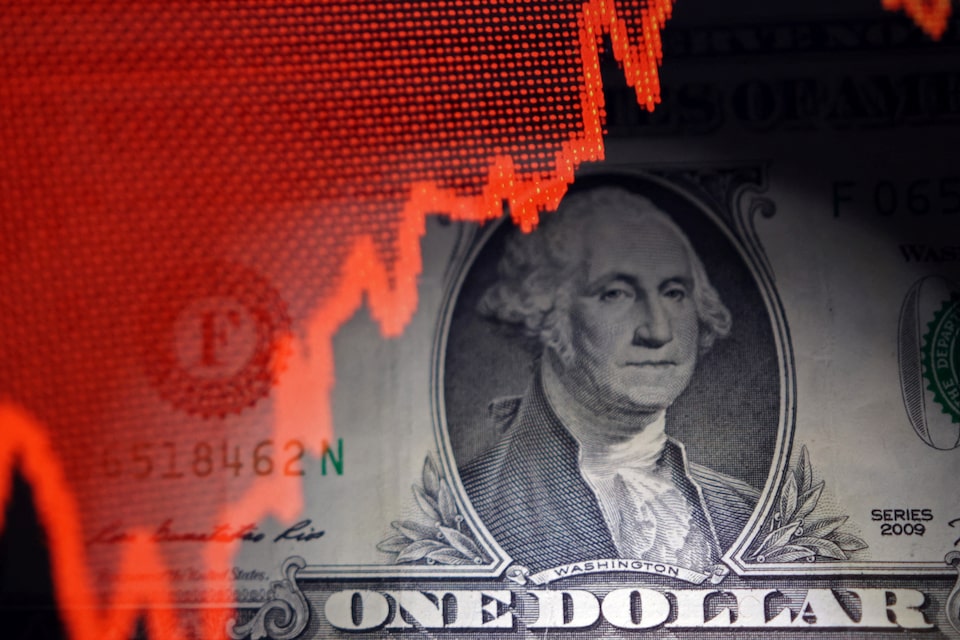U.S. dollar banknote and rising stock graph are seen in this illustration taken April 25, 2025. REUTERS

People ride a motorboat past containers near Yantian port in Shenzhen, Guangdong province, China May 9, 2025. REUTERS
Summary
- China cites ‘constructive’ trade talks with US
- S&P 500 futures jump, China stocks edge higher
- Dollar modestly firmer vs safe haven currencies
- Gold eases back, oil prices bounce
SYDNEY, May 12 (Reuters) – Wall Street stock futures climbed and the dollar firmed against safe haven peers on Monday as signs of progress in U.S.-China trade talks boosted hopes a global recession might be avoided, though specifics were still sorely lacking.
Geopolitical tensions also looked to be easing as a fragile ceasefire held between India and Pakistan, while Ukrainian President Volodymyr Zelenskiy said he was ready to meet Vladimir Putin in Turkey on Thursday for talks.
Over in Geneva, U.S. Treasury Secretary Scott Bessent touted “substantial progress” in trade discussions, while Chinese officials said the sides had reached “important consensus” and agreed to launch another new economic dialogue forum.
A joint statement is expected later on Monday, though it was notable that neither side mentioned tariff rates specifically.
“What we seem to have here, then, is a broad framework under which the two nations can conduct further talks, to reach a broader trade agreement,” said Michael Brown, a senior research strategist at Pepperstone.
“Not the worst case outcome that was possible from this weekend’s talks, far from it, but not a concrete deal either,” he added. “Does this progress allow for any tariffs to be paused, reduced, or rolled back, and if so for how long?”
Investors are hoping the White House will soon scale back the 145% tariff on Chinese goods, even if only back to the 60% first flagged by President Donald Trump.
Trump still seems wedded to keeping broad tariffs in place no matter what, which will drag on economic growth and push up prices, but any trade progress could help dodge a sharp downturn.
Markets reacted by pushing S&P 500 futures up 1.2%, while Nasdaq futures rose 1.4%. EUROSTOXX 50 futures firmed 0.9%, while FTSE futures added 0.4% and DAX futures 0.7%.
Japan’s Nikkei edged up 0.3%, while South Korea gained 0.4%.
Chinese blue chips firmed 0.8%, though data over the weekend showed factory-gate prices posted the steepest drop in six months in April while consumer prices fell for a third month.
The dollar added 0.4% on the safe haven yen to reach 145.90, though it was off an early five-week peak of 146.31. The euro dipped 0.2% to $1.1224 and the dollar index edged up 0.2% to 100.60.
The dollar also dipped 0.2% on the offshore Chinese yuan to 7.2278 , and back toward last week’s low of 7.1846.
A FRUGAL FED
Trump’s erratic trade policies have put the dollar under pressure in recent weeks, though it gained some support last week when the Federal Reserve signalled it was in no rush to cut interest rates again.
Data on U.S. consumer prices for April due this week could offer an early hint of the impact of import levies on inflation, while retail sales are seen flatlining in April after a pre-tariff surge the month before.
Earnings from retail giant Walmart (WMT.N), on Thursday should provide colour on demand and how soon shelves might start to empty of Chinese goods.
“We expect it will not be until the May CPI data are out before we see broad evidence of tariffs showing up in inflation data,” analysts at ANZ wrote in a note.
“In this regard, we think June is too early for the Fed to cut rates and maintain our view that Q3, and most probably September, is a more realistic time frame,” they added. “That would give the opportunity to observe the impact of higher tariffs on both the price level and inflation persistence.”
Markets further trimmed the outlook for easing on Monday, with Fed fund futures down between 3 and 7 ticks. The chance of a rate cut in June is now only 17%, down from more than 60% a month ago, while a July move is seen as a 59% chance.
A host of Fed officials speak this week, led by Chair Jerome Powell on Thursday.
The general increase in risk appetite hurt gold, which has been on a tear in recent weeks as investors sought the safety in the physical metal. Gold was off 1.7% at $3,268 an ounce , short of the April all-time peak of $3,500.
Oil prices went the other way on hopes progress in trade talks would lessen the risk of a major economic downturn, though plans for increased supply by OPEC+ remain a headwind.
Brent rose 29 cents to $64.20 a barrel, while U.S. crude added 30 cents to $61.32 per barrel.
Reporting by Wayne Cole; Editing by Sam Holmes and Shri Navaratnam





